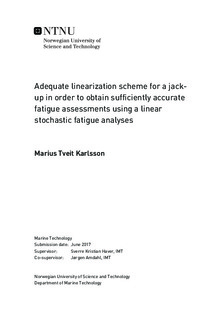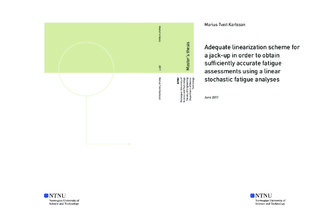| dc.description.abstract | Different techniques for linearizing the response of drag dominated structures is in
this work inspected in terms of fatigue damage. To establish reference response
characteristics, time domain simulations are carried out. Time domain simulations
must be considered as state of the art methods for estimating fatigue damage., but
do however demand huge computational capabilities.
Linear potential theory is used to calculate wave kinematics. To compensate for the
deviation to higher order wave kinematics, adjusted drag coefficients are used. The
JONSWAP spectrum is used to generate stochastic surface elevation and forces,
which is realized using both randomness in phase and amplitude. This insures that
a signal is never repeated within a short term sea state.
Stress concentration factors are used to generate stress processes from beam reac-
tions. To calculate both cycle ranges, and amount of cycles, the rainflow algorithm
is utilized, which result in stress range records that are used as input to SN curves
and miner summation.
Ground conditions are selected to give a highest natural period of 7.67s, which
is within energetic areas of the scatter diagram. Large dynamical amplifications
contribute to move most important fatigue damage sea state down to a spectral
peak period of 8.5s.
The linearization consists of evaluating the response of the structure to different
harmonic input components with different frequencies in order to create transfer
functions. In this regard, the question is how the wave heights used as input to these
harmonic components is selected. Three schemes of selecting these are inspected.
The two most promising are achieved by keeping the steepness or the ratio between
height and period constant. They overestimate the total accumulated damage
during 56 years by 20 % and 100% respectively. The steepness or the constant
height-period ratio is calibrated by matching a spectrally calculated wave action
with a deterministic calculated wave action. This calibration process is working
well, and gives reasonable calibrated values. Both methods tend to be efficient and
gives reasonable results. Whether the constant steepness approach is conservative
might be questioned especially at higher frequencies. The constant height-period
ratio however insures conservatism also at larger frequencies.
It might also be possible to switch the drag term to a linear term and replace the
drag coefficient by a linear drag coefficient. This might open up | |

